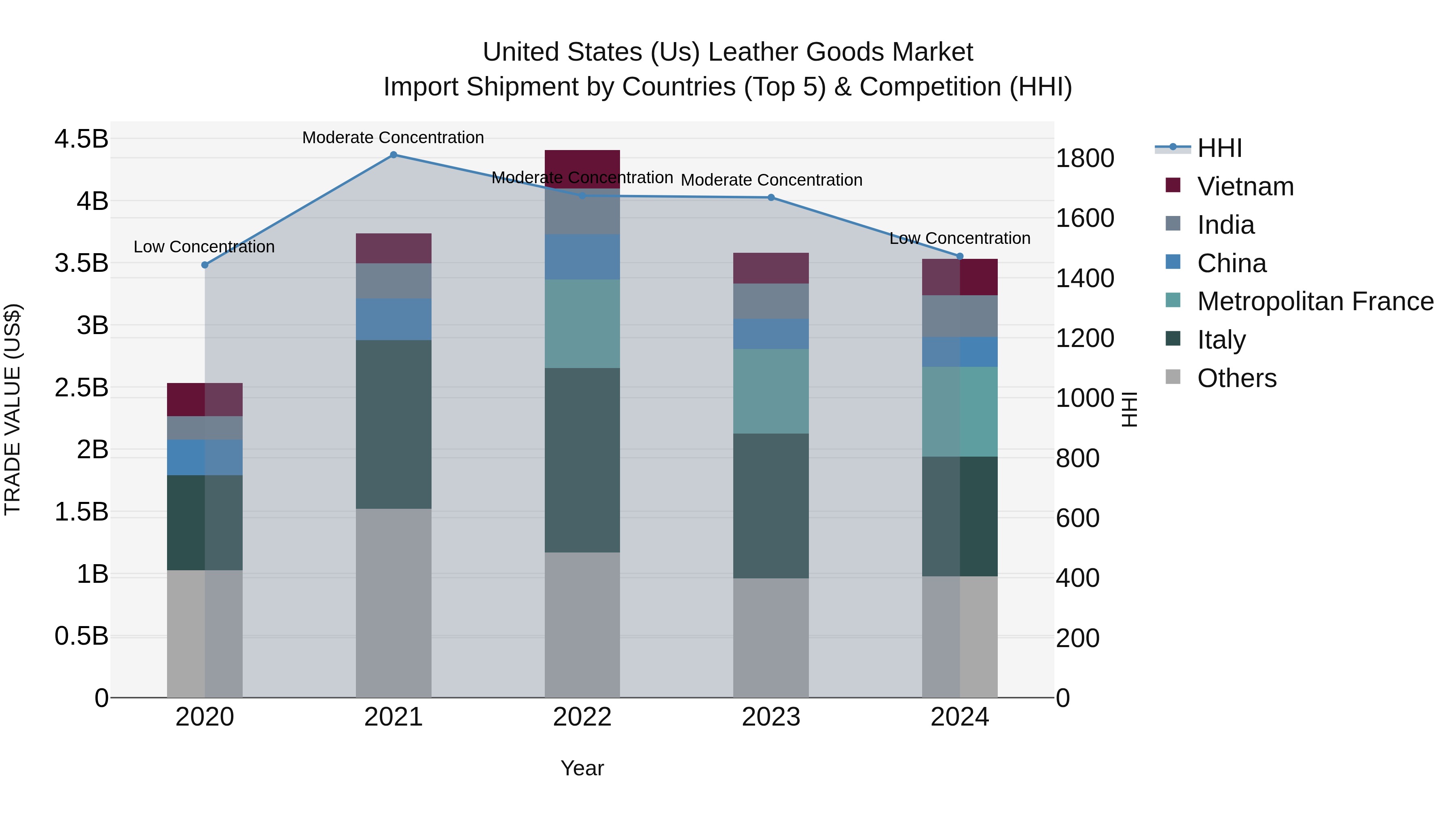US Leather goods Market (2025-2031) | Outlook, Size, Value, Companies, Growth, Industry, Forecast, Share, Trends, Revenue & Analysis
Market Forecast By Product Type (Footwear, Luggage, Wallets & Purses, Clothing and Apparel, Others), By Distribution Channel (Supermarkets/Hypermarkets, Convenience Stores, Online Stores) And Competitive Landscape
| Product Code: ETC019461 | Publication Date: Oct 2020 | Updated Date: Nov 2025 | Product Type: Report | |
| Publisher: 6Wresearch | Author: Ravi Bhandari | No. of Pages: 70 | No. of Figures: 35 | No. of Tables: 5 |
United States (US) Leather Goods Market Top 5 Importing Countries and Market Competition (HHI) Analysis
The United States saw a diverse range of leather goods imports in 2024, with top exporters including Italy, Metropolitan France, India, Vietnam, and Cambodia. The market exhibited a shift from moderate to low concentration, indicating increased competition among suppliers. Despite a slight decline in growth rate from 2023 to 2024, the compound annual growth rate (CAGR) for 2020-24 remained strong at 8.67%. This suggests sustained demand for leather goods in the US market, with opportunities for both established and emerging players to capitalize on the evolving trends.

US Leather goods Market Highlights
| Report Name | US Leather goods Market |
| Forecast period | 2025-2031 |
| CAGR | 8.6% |
| Growing Sector | Apparel |
Topics Covered in the US Leather Goods Market Report
The US Leather Goods market report thoroughly covers the market by product type, by distribution channel and competitive Landscape. The report provides an unbiased and detailed analysis of the on-going market trends, opportunities/high growth areas, and market drivers which would help the stakeholders to devise and align their market strategies according to the current and future market dynamics.
US Leather Goods Market Synopsis
The US leather goods market is witnessing substantial growth, driven by a rising demand for luxury products among consumers. With an increased awareness about premium quality materials and craftsmanship, there is a significant uptick in the purchase of high-end leather accessories such as handbags, wallets, and belts. This trend is further fueled by the growing disposable income and the strong presence of leading global luxury brands in the US market. Additionally, nonetheless, the market also faces evolving trends that shape consumer preferences. One notable trend is the increasing interest in sustainability and ethical fashion. Consumers are more conscious than ever about the environmental impact of their purchases, leading to a surge in demand for eco-friendly and vegan leather alternatives. Additionally, the digital transformation has revolutionized the leather goods shopping experience, with online platforms becoming a preferred purchasing channel. This shift has prompted brands to enhance their e-commerce strategies and digital presence to meet the changing buying habits of consumers.
According to 6Wresearch, US Leather Goods market size is projected to grow at a CAGR of 8.6% during 2025-2031. Several key factors are driving the growth of the United States leather goods market. Firstly, the luxury market's expansion plays a crucial role, as affluent consumers seek high-quality leather products that symbolize status and elegance. This demand is particularly strong for unique and artisanal items that offer a blend of tradition and contemporary design. Secondly, technological advancements in e-commerce and digital marketing have made it easier for brands to reach a wider audience, enhancing consumer engagement and facilitating the convenience of online shopping. Additionally, innovative developments in sustainable and synthetic leather are attracting environmentally conscious customers, broadening the market's appeal. Lastly, the influence of fashion influencers and social media platforms cannot be overstated, as they play a pivotal role in shaping consumer trends and preferences, further stimulating market growth.
Government Initiatives Introduced in the US Leather Goods Market
Government initiatives have also had a significant impact on the U.S. leather goods market. Efforts to support sustainable practices within the industry are gaining momentum, with regulations and incentives designed to promote the use of eco-friendly materials and reduce the environmental footprint of leather production. Federal and state governments are increasingly investing in research and development projects aimed at improving the sustainability of leather goods, including the exploration of alternative materials that mimic leather's durability and aesthetic appeal but are more environmentally benign. Furthermore, trade policies and export-import regulations are being fine-tuned to foster growth in the leather goods sector, encouraging domestic production and making it more competitive on a global scale. Steadily, these actions have boosted the US Leather Goods Market Share. Additionally, these government strategies not only address environmental and ethical concerns but also aim to bolster the market by supporting innovation and ensuring the quality and reputation of U.S. leather goods worldwide
Key Players in the US Leather Goods Market
Prominent players in the U.S. leather goods market include Coach, Inc., Michael Kors Holdings Limited, Kate Spade & Company, and Fossil Group, Inc. These companies are distinguished by their strong brand recognition, extensive distribution networks, and innovative product offerings that resonantly cater to a diverse consumer base's aesthetics and functional needs. They leverage advanced marketing strategies and collaborations with fashion icons to enhance their visibility and appeal. Moreover, the companies’ hold immense United States (US) Leather Goods Market Revenues. Furthermore, these industry leaders are increasingly investing in sustainability and ethical practices, responding to consumer demand for environmentally responsible products. Their efforts in adopting eco-friendly materials and production processes are setting new standards in the leather goods industry, aligning luxury with sustainability.
Future Insights of the United States (US) Leather Goods Market
Looking ahead, the future of the U.S. leather goods market appears promising, with sustainability and technological innovation at the forefront of growth. The integration of advanced technologies such as 3D printing and AI in design and manufacturing processes is expected to revolutionize product customization, reduce waste, and further enhance supply chain efficiency. Additionally, the increasing consumer consciousness towards ethical production and eco-friendly materials is likely to spur the development of new, sustainable leather alternatives, driving a significant shift in consumer preferences and industry standards. This evolution towards more responsible production practices and innovative materials, combined with strong market dynamics and consumer demand, positions the U.S. leather goods industry for continued growth and transformation in the years to come.
Market Analysis by Product Type
According to Ravi Bhandari, Research Head, 6Wresearch, within this burgeoning market, the product range is both extensive and diverse, catering to a wide array of preferences and necessities. Footwear, encompassing everything from luxury boots to comfortable sandals, remains a stalwart of the leather goods sector, combining style with durability. Luggage, offering options from high-end travel bags to practical backpacks, emphasizes both function and fashion for the modern traveler. Wallets & Purses continue to be indispensable accessories, blending aesthetic appeal with practicality. Clothing and Apparel, which includes leather jackets, belts, and trousers, stands out for its timeless appeal and capability to elevate any outfit. Lastly, the category labeled Others captures an assortment of leather products such as gloves, hats, and accessories, proving the material's versatility and enduring popularity.
Market Analysis by Distribution Channel
The distribution channels for leather goods are as varied as the products themselves, ensuring that these items reach a broad spectrum of consumers. Supermarkets/Hypermarkets have emerged as one-stop shops, providing customers the convenience of finding a variety of leather goods under one roof. Convenience Stores, while smaller in scale, strategically located in neighbourhoods and busy streets, cater to quick, last-minute purchases, making leather accessories like wallets and belts easily accessible. Online Stores, on the other hand, have redefined shopping paradigms, offering an extensive selection of leather goods with the added advantages of easy comparison, home delivery, and often, competitive pricing. These varied distribution channels play pivotal roles in ensuring that leather products are readily available to meet the diverse needs and preferences of consumers worldwide.
Key Attractiveness of the Report
- 10 Years Market Numbers.
- Historical Data Starting from 2021 to 2024.
- Base Year: 2024.
- Forecast Data until 2031.
- Key Performance Indicators Impacting the Market.
- Major Upcoming Developments and Projects.
Key Highlights of the Report:
- US Leather Goods Market Overview
- US Leather Goods Market Outlook
- US Leather Goods Market Forecast
- Market Size of US Leather goods Market
- Forecast of United States (US) Leather goods Market, 2031
- Historical Data and Forecast of US Leather goods Revenues & Volume for the Period 2021 - 2031
- US Leather goods Market Trend Evolution
- US Leather goods Market Drivers and Challenges
- US Leather goods Price Trends
- US Leather goods Porter's Five Forces
- US Leather goods Industry Life Cycle
- Historical Data and Forecast of US Leather goods Market Revenues & Volume By Product Type for the Period 2021 - 2031
- Historical Data and Forecast of US Leather goods Market Revenues & Volume By Footwear for the Period 2021 - 2031
- Historical Data and Forecast of US Leather goods Market Revenues & Volume By Luggage for the Period 2021 - 2031
- Historical Data and Forecast of US Leather goods Market Revenues & Volume By Wallets & Purses for the Period 2021 - 2031
- Historical Data and Forecast of US Leather goods Market Revenues & Volume By Clothing and Apparel for the Period 2021 - 2031
- Historical Data and Forecast of US Leather goods Market Revenues & Volume By Others for the Period 2021 - 2031
- Historical Data and Forecast of US Leather goods Market Revenues & Volume By Distribution Channel for the Period 2021 - 2031
- Historical Data and Forecast of US Leather goods Market Revenues & Volume, By Supermarkets/Hypermarkets for the Period 2021 - 2031
- Historical Data and Forecast of US Leather goods Market Revenues & Volume, By Convenience Stores for the Period 2021 - 2031
- Historical Data and Forecast of US Leather goods Market Revenues & Volume, By Online Stores for the Period 2021 - 2031
- US Leather goods Import Export Trade Statistics
- Market Opportunity Assessment, By Product Type
- Market Opportunity Assessment, By Distribution Channel
- US Leather goods Top Companies Market Share
- US Leather goods Competitive Benchmarking, By Technical and Operational Parameters
- US Leather goods Company Profiles
- US Leather goods Key Strategic Recommendations
Markets Covered
The US Leather Goods market report provides a detailed analysis of the following market segments:
By Product Type
- Footwear
- Luggage
- Wallets & Purses
- Clothing and Apparel
- Others
By Distribution Channel
- Supermarkets/Hypermarkets
- Convenience Stores
- Online Stores
US Leather goods Market (2025-2031): FAQs
| 1 Executive Summary |
| 2 Introduction |
| 2.1 Key Highlights of the Report |
| 2.2 Report Description |
| 2.3 Market Scope & Segmentation |
| 2.4 Research Methodology |
| 2.5 Assumptions |
| 3 US Leather goods Market Overview |
| 3.1 US Country Macro Economic Indicators |
| 3.2 US Leather goods Market Revenues & Volume, 2021 & 2031F |
| 3.3 US Leather goods Market - Industry Life Cycle |
| 3.4 US Leather goods Market - Porter's Five Forces |
| 3.5 US Leather goods Market Revenues & Volume Share, By Product Type, 2021 & 2031F |
| 3.6 US Leather goods Market Revenues & Volume Share, By Distribution Channel, 2021 & 2031F |
| 4 US Leather goods Market Dynamics |
| 4.1 Impact Analysis |
| 4.2 Market Drivers |
| 4.2.1 Increasing disposable income of consumers in the US, leading to higher spending on luxury goods such as leather goods. |
| 4.2.2 Growing popularity of sustainable and ethically sourced leather products among environmentally conscious consumers. |
| 4.2.3 Rising demand for premium and personalized leather goods, driven by a desire for unique and high-quality products. |
| 4.3 Market Restraints |
| 4.3.1 Fluctuating raw material prices, such as leather, impacting the production costs and profit margins of leather goods manufacturers. |
| 4.3.2 Intense competition from synthetic leather and alternative materials, affecting the market share of traditional leather goods. |
| 4.3.3 Economic downturns and fluctuations in consumer spending, leading to a decrease in demand for luxury leather goods. |
| 5 US Leather goods Market Trends |
| 6 US Leather goods Market, By Types |
| 6.1 US Leather goods Market, By Product Type |
| 6.1.1 Overview and Analysis |
| 6.1.2 US Leather goods Market Revenues & Volume, By Product Type, 2021-2031F |
| 6.1.3 US Leather goods Market Revenues & Volume, By Footwear, 2021-2031F |
| 6.1.4 US Leather goods Market Revenues & Volume, By Luggage, 2021-2031F |
| 6.1.5 US Leather goods Market Revenues & Volume, By Wallets & Purses, 2021-2031F |
| 6.1.6 US Leather goods Market Revenues & Volume, By Clothing and Apparel, 2021-2031F |
| 6.1.7 US Leather goods Market Revenues & Volume, By Others, 2021-2031F |
| 6.2 US Leather goods Market, By Distribution Channel |
| 6.2.1 Overview and Analysis |
| 6.2.2 US Leather goods Market Revenues & Volume, By Supermarkets/Hypermarkets, 2021-2031F |
| 6.2.3 US Leather goods Market Revenues & Volume, By Convenience Stores, 2021-2031F |
| 6.2.4 US Leather goods Market Revenues & Volume, By Online Stores, 2021-2031F |
| 7 US Leather goods Market Import-Export Trade Statistics |
| 7.1 US Leather goods Market Export to Major Countries |
| 7.2 US Leather goods Market Imports from Major Countries |
| 8 US Leather goods Market Key Performance Indicators |
| 8.1 Consumer sentiment towards sustainable and eco-friendly leather products. |
| 8.2 Number of collaborations with fashion designers or celebrities for exclusive leather goods collections. |
| 8.3 Adoption rate of innovative technologies in the production and design of leather goods. |
| 8.4 Percentage of repeat customers and customer loyalty programs in the leather goods market. |
| 8.5 Trends in online engagement and social media presence of leather goods brands. |
| 9 US Leather goods Market - Opportunity Assessment |
| 9.1 US Leather goods Market Opportunity Assessment, By Product Type, 2021 & 2031F |
| 9.2 US Leather goods Market Opportunity Assessment, By Distribution Channel, 2021 & 2031F |
| 10 US Leather goods Market - Competitive Landscape |
| 10.1 US Leather goods Market Revenue Share, By Companies, 2024 |
| 10.2 US Leather goods Market Competitive Benchmarking, By Operating and Technical Parameters |
| 11 Company Profiles |
| 12 Recommendations |
| 13 Disclaimer |
- Single User License$ 1,995
- Department License$ 2,400
- Site License$ 3,120
- Global License$ 3,795
Search
Thought Leadership and Analyst Meet
Our Clients
Related Reports
- Germany Breakfast Food Market (2026-2032) | Industry, Share, Growth, Size, Companies, Value, Analysis, Revenue, Trends, Forecast & Outlook
- Australia Briquette Market (2025-2031) | Growth, Size, Revenue, Forecast, Analysis, Trends, Value, Share, Industry & Companies
- Vietnam System Integrator Market (2025-2031) | Size, Companies, Analysis, Industry, Value, Forecast, Growth, Trends, Revenue & Share
- ASEAN and Thailand Brain Health Supplements Market (2025-2031) | Strategy, Consumer Insights, Analysis, Investment Trends, Opportunities, Growth, Size, Share, Industry, Revenue, Segments, Value, Segmentation, Supply, Forecast, Restraints, Outlook, Competition, Drivers, Trends, Demand, Pricing Analysis, Competitive, Strategic Insights, Companies, Challenges
- ASEAN Bearings Market (2025-2031) | Strategy, Consumer Insights, Analysis, Investment Trends, Opportunities, Growth, Size, Share, Industry, Revenue, Segments, Value, Segmentation, Supply, Forecast, Restraints, Outlook, Competition, Drivers, Trends, Demand, Pricing Analysis, Competitive, Strategic Insights, Companies, Challenges
- Europe Flooring Market (2025-2031) | Outlook, Share, Industry, Trends, Forecast, Companies, Revenue, Size, Analysis, Growth & Value
- Saudi Arabia Manlift Market (2025-2031) | Outlook, Size, Growth, Trends, Companies, Industry, Revenue, Value, Share, Forecast & Analysis
- Uganda Excavator, Crane, and Wheel Loaders Market (2025-2031) | Strategy, Consumer Insights, Analysis, Investment Trends, Opportunities, Growth, Size, Share, Industry, Revenue, Segments, Value, Segmentation, Supply, Forecast, Restraints, Outlook, Competition, Drivers, Trends, Demand, Pricing Analysis, Competitive, Strategic Insights, Companies, Challenges
- Rwanda Excavator, Crane, and Wheel Loaders Market (2025-2031) | Strategy, Consumer Insights, Analysis, Investment Trends, Opportunities, Growth, Size, Share, Industry, Revenue, Segments, Value, Segmentation, Supply, Forecast, Restraints, Outlook, Competition, Drivers, Trends, Demand, Pricing Analysis, Competitive, Strategic Insights, Companies, Challenges
- Kenya Excavator, Crane, and Wheel Loaders Market (2025-2031) | Strategy, Consumer Insights, Analysis, Investment Trends, Opportunities, Growth, Size, Share, Industry, Revenue, Segments, Value, Segmentation, Supply, Forecast, Restraints, Outlook, Competition, Drivers, Trends, Demand, Pricing Analysis, Competitive, Strategic Insights, Companies, Challenges
Industry Events and Analyst Meet
Whitepaper
- Middle East & Africa Commercial Security Market Click here to view more.
- Middle East & Africa Fire Safety Systems & Equipment Market Click here to view more.
- GCC Drone Market Click here to view more.
- Middle East Lighting Fixture Market Click here to view more.
- GCC Physical & Perimeter Security Market Click here to view more.
6WResearch In News
- Doha a strategic location for EV manufacturing hub: IPA Qatar
- Demand for luxury TVs surging in the GCC, says Samsung
- Empowering Growth: The Thriving Journey of Bangladesh’s Cable Industry
- Demand for luxury TVs surging in the GCC, says Samsung
- Video call with a traditional healer? Once unthinkable, it’s now common in South Africa
- Intelligent Buildings To Smooth GCC’s Path To Net Zero


















